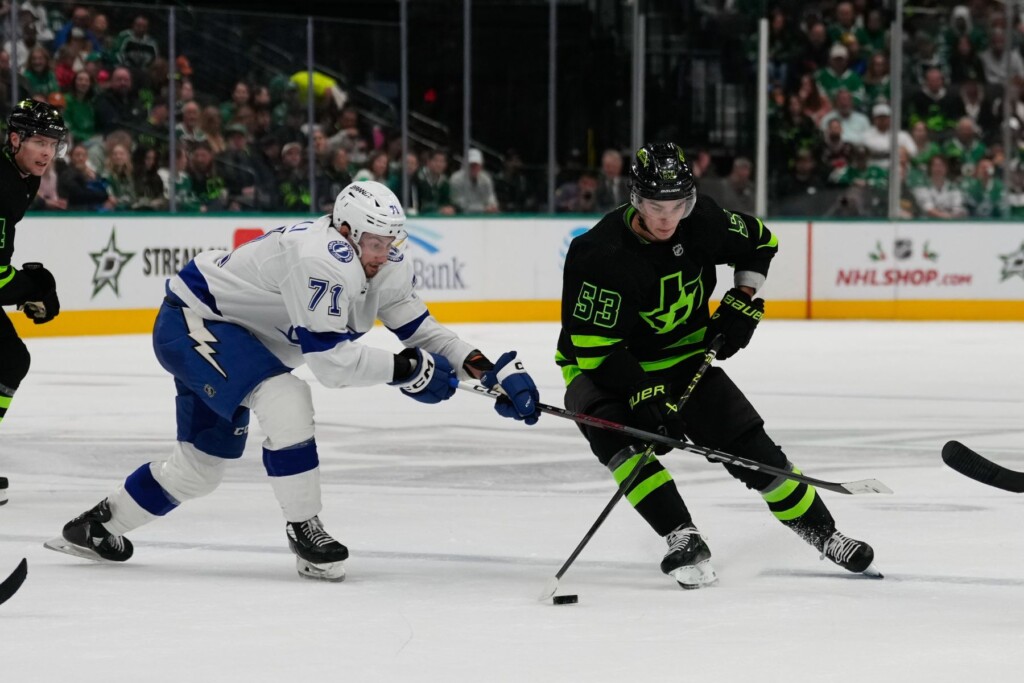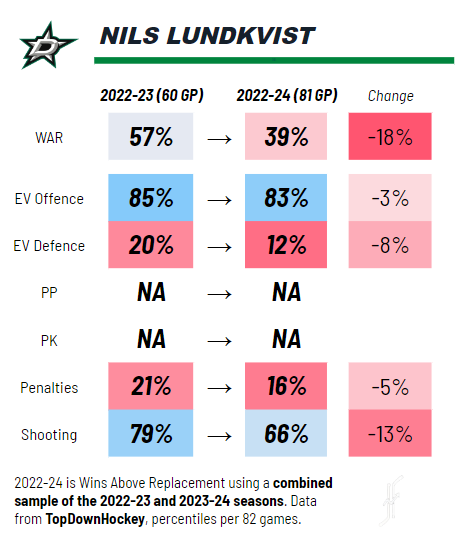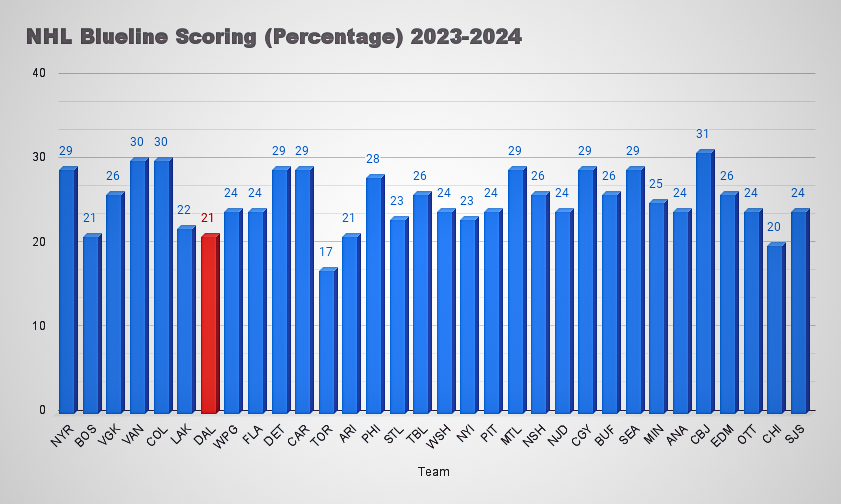When Jim Nill traded a future first-round pick for Nils Lundkvist in September 2022, it was regarded as a gamble. Lundkvist was a mystery box, sure, but he was a mystery box who made history by setting the Swedish pro league’s record for under-20 defensemen scoring. His first year under Pete DeBoer, however, followed a familiar story that happens throughout the NHL, in which teams lose patience molding promising young players they invested significant resources to acquire.
Sure enough, after 60 regular-season games under Lundkvist’s belt, Thomas Harley’s rapid emergence and Joel Hanley’s steady, if unspectacular play, made the Swede expendable come playoff time. Twenty-four games into the new season, Harley—deservedly—is an institution, while Hanley is already cutting into Lundkvist’s playing time. The lack of trust from the coaching staff was made explicit by DeBoer this week, when he commented on Lundkvist’s untimely penalties defending. As a result, Lundkvist is playing a full two minutes fewer this year than last, going from over 14 minutes a game at even strength to a little over 12 this season. The flow of the game has had little to do with it, too, with Lundkvist getting functionally benched through entire periods.
The angst in the air is not only palpable, but valid. Criticism of Lundkvist’s development has implications much bigger than fans being upset about a shiny prospect not getting ice time.
Because there are so many ways to approach the Lundkvist topic, it’s easy to forget about his value as a player. Who is he? A puck mover with no defense? A defensive player who can make plays with the puck? Something else yet to be determined? For the Stars, it doesn’t matter. They’re in to win it, and players have to perform in order for them to win.
So, is Lundkvist performing? The former Rangers prospect is still young, so the following player card warrants some reservation, but don’t confuse limited data with data that’s pattern-free.
It’s ugly. Across the board, the second half of Lundkvist’s short career has seen a decline in his shift-to-shift offense, shift-to-shift defense, penalty differential, shooting ability, and, thus, his bottom-line value (or Wins Above Replacement).
Case closed, right?
On the contrary. This is where things get even murkier. To say that Lundkvist has failed to develop is to say only that Lundkvist has failed to develop within his brief tenure. That tenure is missing key junctures in his development track: playoff experience and power-play minutes, both of which might have benefited him this season. That’s something of a failure considering that the range of the pick Dallas gave up has yielded talents like Logan Stankoven (47th overall in 2021) and Mavrik Bourque (30th overall in 2020), who are co-leading the AHL in scoring. According to The Athletic’s Dom Luszczyszyn, Dallas added 147 wins between 2008 and 2018 through the draft, by far a league best. So the idea that Dallas simply gave up “magic beans” is nonsense. And it’s only marginally less of a failure to write off a 23-year-old well before all of his growth paths have been explored.
But to say that Lundkvist has failed to develop is to also say that the Stars’ defense is failing to develop into a contending blueline. After all, what does it say about Ryan Suter not being able to help carry Lundkvist in their 447 minutes together last season? What does it say about Esa Lindell not being able to help carry Lundkvist in their 126 minutes together this season? Sure, their job is not to babysit. “The NHL is not a developmental league,” as the hackneyed saying goes. But shouldn’t good veteran blueliners be able to elevate their inexperienced partners? You could fault Lundkvist for not developing on the job quick enough, but two things can be true at once: Lundkvist hasn’t made the most of his opportunities, and Dallas doesn’t have a blueline that can help leverage his strengths within those opportunities.
That’s where the Lundkvist situation becomes a Dallas situation. The Stars have profiled like a strong defensive team since DeBoer took over, but they’re largely trending downward. Last year they were third in expected goals-against at even strength; this year, they’re eighth. Last year they were seventh in registered goals-against at even strength; this year, they’re ninth.
The modern game needs contributions both ways, however, and Dallas has also failed to manufacture consistent offense, ranking 14th in even-strength expected goals-for since last season. And that’s where you’d like to see Lundkvist—who is fourth among defenders in scoring and second in scoring when you adjust for minutes—get a longer leash: the Stars need offense from their blueline, not just defense.
Defensemen scoring is up this season. Quinn Hughes and Cale Makar have gone full HAM, registering more than 30 points each. Seven other blueliners, including Victor Hedman and Rasmus Dahlin, have 20 or more. Is Dallas benefiting from the trend of teams getting more from their blueline?
Not even close. (Teams have been arranged per their league rank from left to right.)
Only two teams have generated less offense from their defense core than Dallas. One is a tanking team (Chicago) with only five regulation wins, and the other has the same amount of regulation wins as the tanking team (Toronto). Three of the teams with the highest-producing bluelines are in the top five. Four teams in front of Dallas will be potential playoff opponents. Any way you slice it, the Stars fall well below the 24 percent average point share that teams get from the back end, much less the percentage that other Cup contenders receive.
Can Lundkvist help change that? The answer to that question misses the point. Even if Lundkvist were to become an impact puck-moving defenseman, if that occurs in the next two years, that wouldn’t help Dallas right now, would it? Of course, if he were to become the next Julius Honka, that also doesn’t help Dallas right now. The real question is how much of Lundkvist’s slow development is hurting the Stars.
I don’t know. But would it hurt Dallas any more than Suter’s minus-4 on Monday night versus Tampa Bay? Would it hurt any more than Lindell and Jani Hakanpaa’s shift-to-shift failures to exit the zone with possession? Speaking of Lindell and Hakanpaa, dig deeper into their shorthanded stats, and it’s clear that goaltending is the reason Dallas is ranked third on the PK, not their defensive chops. (Among 74 defenders with at least 50 shorthanded minutes, both rank in the bottom 20 in unblocked shots allowed.)
Let’s not play favorites, either. Miro Heiskanen is taking almost a shot and half less per game this year versus last. He’s gone from 2.17 points per game to 1.45. His giveaways per game have gone up, while his takeaways have gone down. This was supposed to be his big year, yet he ranks 29th in scoring among defensemen, something that goes beyond falling short of expectation for a player who finished sixth in that category last year.
The point here is not that the sky is falling. The point is that if you think it is, then the sky shouldn’t be falling on Lundkvist alone.
Development is the butchered word of the day precisely because development happens to all things, from microbes to hockey prospects to contending teams. It can be rapid or gradual, but it’s always cumulative. Vegas developed into a Cup contender rapidly; L.A. achieved it gradually. If Dallas can’t live with Lundkvist’s gradual development, then the trade deadline will need to be a source for rapid improvement of the blueline.
I don’t want to come across as negative or ignore the bright spots in what has been a mostly successful stretch for Dallas. But “very successful” is not the bar the Stars have set. Right now, it’s looking like they’re headed into the postseason with the exact same blueline that struggled in last year’s playoffs, and it’s easy to imagine this year’s early-round competition looking much tougher than a gritty Minnesota team that couldn’t score or an injured, plucky underdog like Seattle.
Lundkvist won’t change that postseason equation, but if he’s part of the Stars’ future, maybe they should develop a tolerance for patience. If he’s not, then maybe they should stop staying so patient with the rest of the blueline’s flaws.
Author









